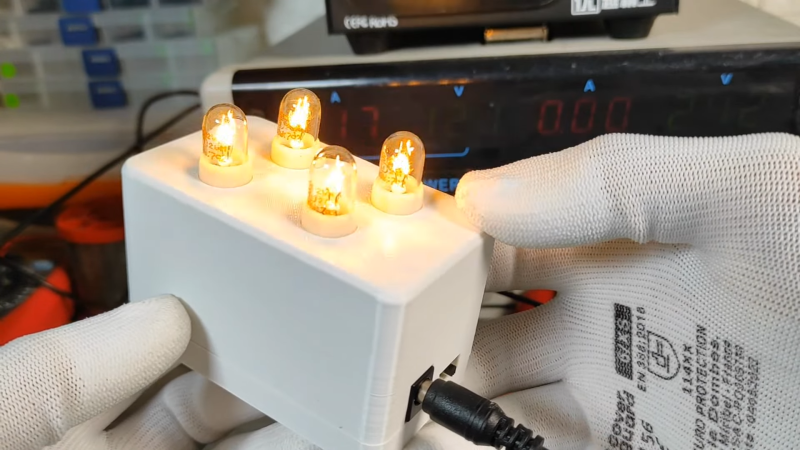Modern cars tend to have quite advanced lighting systems, all integrated under the control of the car’s computer. Back in the day, though, things like brake lights and indicators were all done with analog electronics. If your classic car needs a good old-fashioned flasher module, you might find this build from [DIY Guy Chris] useful.
It’s an all-analog build, with no need for microcontrollers or other advanced modern contrivances. Instead, a little bipolar PNP transistor and a beefier NPN MOSFET as an oscillator, charging and discharging a capacitor to create the desired flashing behavior. Changing the size of the main capacitor changes the flash rate. The MOSFET is chosen as running 12 volt bulbs requires a decent amount of current. The design as drawn is intended to run up to eight typical automotive bulbs, such as you might find in indicator lamps. However, [Chris] demonstrates the circuit with just four.
Flasher circuits were in regular use well into the 1990s. The original Mazda Miata has a very similar circuit tucked up under the dashboard to run the turn signals. These circuits can be hard to find for old cars, so building your own may be a useful workaround if you’re finding parts hard to come by. Video after the break.















Tsk tsk Could have used a bi-metallic strip (my attempt at a 555 joke).
Which ol’ timey series connected flasher relays actually used.
Though that’s the joke I guess…
And solid state replacements are readily available.
A few years ago I built a.. I’ll be generous and call it a “logic unit”—out of automotive relays plus a turn-signal relay to control the combined front/rear turn signals on my motorcycle + the motorcycle tail lights were the same rear turn signal bulbs.
So it would direct the blinking signal towards the front and rear bulbs in the direction you selected with a switch, plus it would show running lights if the headlight was on (dimmed through a power resistor) and would also take signals from the front or rear brake controls to display the brake lights on both rear bulbs, but if the brakes were on simultaneously with the turn signal then the signal would switch to pulsing the bulb off instead of on on that side.
Probably would’ve been a lot easier with semiconductors. There was a kit for close to $200. I didn’t want to pay. My contraption fits in the back of the headlight shell. I have probably already forgotten how it works and will have to reverse-engineer it when it breaks.
It would probably have been a lot cheaper if you just added a pair of orange/amber bulbs for the rear turn signals.
It has always puzzled me…up until a few years ago, cars with LED brake, running and headlights, still had incandescent lamps in their turn indicators. Only within the past few years have turn signals gone LED.
I had a 1997 Mercury Mountaineer which had an LED 3rd brake light. Now I have a 2007 Ford Expedition which has 5 incandescent bulbs in its 3rd brake light. WTH, Ford?
Another one of Fords better ideas
Just about every turn signal uses a single switched hot wire per side, through the bulb to chassis ground. So this circuit wouldn’t work for that because it switches the ground. It would be fine for a dome light that has a switch to ground, if you wanted to make it flash … for some reason.
If you really, really want a solid state turn signal flasher, use one of the high side driver ICs designed for that purpose. I use a IPS6401. It has an overcurrent, overtemperature shutoff, low leakage, reverse and load dump protection, and status out. You drive it with a 5V logic signal. Or a 555, PUT, UJT, tunnel diode, or bimetal oscillator.
Don’t forget the bad light bulb indicator. On older cars, all lights would flash in rapid mode. Newer ones only flash rapidly the instrument panel indicators
I(‘m still trying to figure out how a bad bulb flashes
If you’re flashing real tungsten bulbs, you should soft-start them to avoid rapid burn-out. The bimetal flashers, crude as they were, still had some series resistance to soften the turn-on current surge. Some also kept a small current flowing in the lamp when off, again to reduce the thermal shock and extend lamp life.
Finally, is the electronic flasher going to provide the “click-clock” to remind you that your turn light is on?
These ciruits are not that hard to find, the company I work for makes in in Connecticut and sells all the standard variations at autozone for 5-10 bucks. While I realize its fun to roll your own, do we really need artificial scarcity to make the project look bigger than it is? No.
A new type of transistor: “NPN MOSFET”
You beat to it, this is the second time in a week I’ve seen mention of PNP/NPN MOSFET’s.
PNP/NPN MOSFETs would be even better, no need to stock them all.
Good to see some sensible circuits every thing uses a microcontroller when a 555 or a few transistors will do the same job with Lee hassle